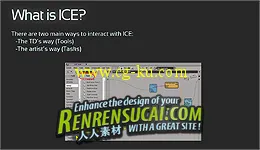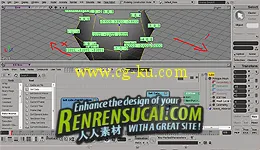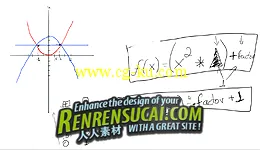本教程是由CMIVFX机构出品的Softimage中ICE Deformers教程****,时长:3小时11分,教程使用软件:Softimage,作者:Gustavo Boehs,官方发布时间:2012年1月3日,语言:英语。
本教学专注于在ICE中创建Deformer,ICE是Softimage中的一个节点制作环境,它能够实现很多不同的东西,使用它你能创建自定义的deformers,动画粒子,角色绑定,流体模拟,甚至还有创建人群。
SOFTIMAGE XSI是AUTO DESK(AVID公司已经被AUTO DESK公司收购!)面向高端三维影视市场的旗舰产品,以其独一无二真正的非线性动画编辑为众多从事三维电脑艺术人员所喜爱。XSI将电脑的三维动画虚拟能力推向了极致。是最佳的动画工具,除了新的非线性动画功能之外,比之前更容易设定Keyframe的传统动画。是制作电影,广告,3D,建筑表现等方面的强力工具。
The topic in this video features Creating Deformers in ICE. ICE (Interactive Creative Environment) is a nodal environment inside Autodesk Softimage that can do a range of different things. You can use it to create custom deformers, animate particles, rig characters, simulate fluids, and even generate crowds.
It doesn matter what you want to do with ICE, there is a set of concepts and nodes that you need to know and understand in order to get going with the tool.
Concepts like data types and data context, order of evaluation, vectors, matrices, arrays, locations and so on...
In this training we are going to build 3 custom deformers. We will start with the easy ones and learn the most basic concepts in ICE. As we move on to more complex deformations, the understanding of more complex concepts will feel natural to you, since you already have your feet wet.
You will find out that with less effort then you thought you can create and deploy custom deformers that extend the capability of what you can do in both modeling and animation. Not only that but the concepts learned here are most valuable for anything else you want to do inside ICE.
Chapter Descriptions
Chapter 1: What is ICE
Before we touch cg-ku.com the software we must first understand what ICE is and what it does. What are the differences on the way artists and TDs view ICE? How do ICE operators work in relation to other operators inside Softimage? And how data flows through nodes?
Chapter 2: My First Deformer
Let’s go for our first encounter with the UI. Getting to know the most important nodes and the most basic concepts in our ICE experience. We get to know about vectors, what type of Data they are and in what Context they are set. We also learn how we can use math nodes to manipulate them.
Chapter 3: Spherize Deformer
With a good cg-ku.com understanding of ICE and its most basic concepts we are ready to tackle a basic deformer. We will be working mainly with vectors, manipulating them with different nodes and using the Debugging tools available in ICE so we understand bit-by-bit how things work. But to finish our tool and make it as user-friendly as possible there are some concepts we still need to address…
Chapter 4: Local and World Spaces
As we will have learned already in this chapter ICE deformations happened in Local Space. But what is Local Space? And what is it World Space, and how do they differ from each other? And more important then that how do we switch values in between both this spaces so we can get our tools working the way we want to?
Chapter 5: Matrices
To answer the question in the last chapter we will need to get into the world of Matrices. Not to be daunted. Matrices are not that complex when you look at them carefully. More importantly what you really need to know is not how they work inside your 3d package, but the matrix operations you need to perform in order to achieve specific results. Like switching in between Local and World Space, or establishing parenting and constraining relations.
Chapter 6: A Compound’s Interface
With the inner parts of our first deformer complete we will understand how to create a nice interface for the artist. How to expose and group parameters. And also how to group nodes in a way they have a broad functionality and may serve you in the future, saving you work on new deformers and effects.
Chapter 7: Squash and Stretch Deformer
With almost all the key concepts in ICE covered we can have some fun in a slightly more complex deformer. The challenge here will not be ICE itself, but the mathematical concepts needed to achieve the effect. We will learn how to graph mathematical functions in ICE and prototype with them in order to find the results we look for. After we solve that we wrap up the deformer in a user-friendly fashion, and even use some parts from our first deformer.
Chapter 8: Collision Deformer
To achieve deformations that results from collisions we will learn the last two ICE concepts in this training, geometry queries and the use of Locations. These are things you will be using all the time, and we could not finish this material without them. But the most important thing about this deformer is the way we will be switching the context of data we work with, this is some major issue for people starting in ICE, and to achieve this effect we will have to do this over and over again. So I’m sure the concept will stick with you.
Gustavo E Boehs
Gustavo E Boehs is a generalist 3d artist from Brazil. He started his career as a Graphic Designer, but soon became very interested in 3d. He moved to São Paulo (Brazils financial capital) looking for good education in this field. The institution he attended used Softimage as its main tool, and what a tool it is to start your 3d venture! Having created a short film, and many advertisement pieces, he has dealt with most aspects of 3d and compositing and gained a deep all around knowledge of SI's tools and workflow, as well as some experience in other packages like Maya, Max and Cinema 4d.
Project Contents
All cmiVFX videos come with all the training materials you can need right from our website. No matter what time of day, your location, or how your feeling, cmiVFX will be there waiting for you!






发布日期: 2012-3-21